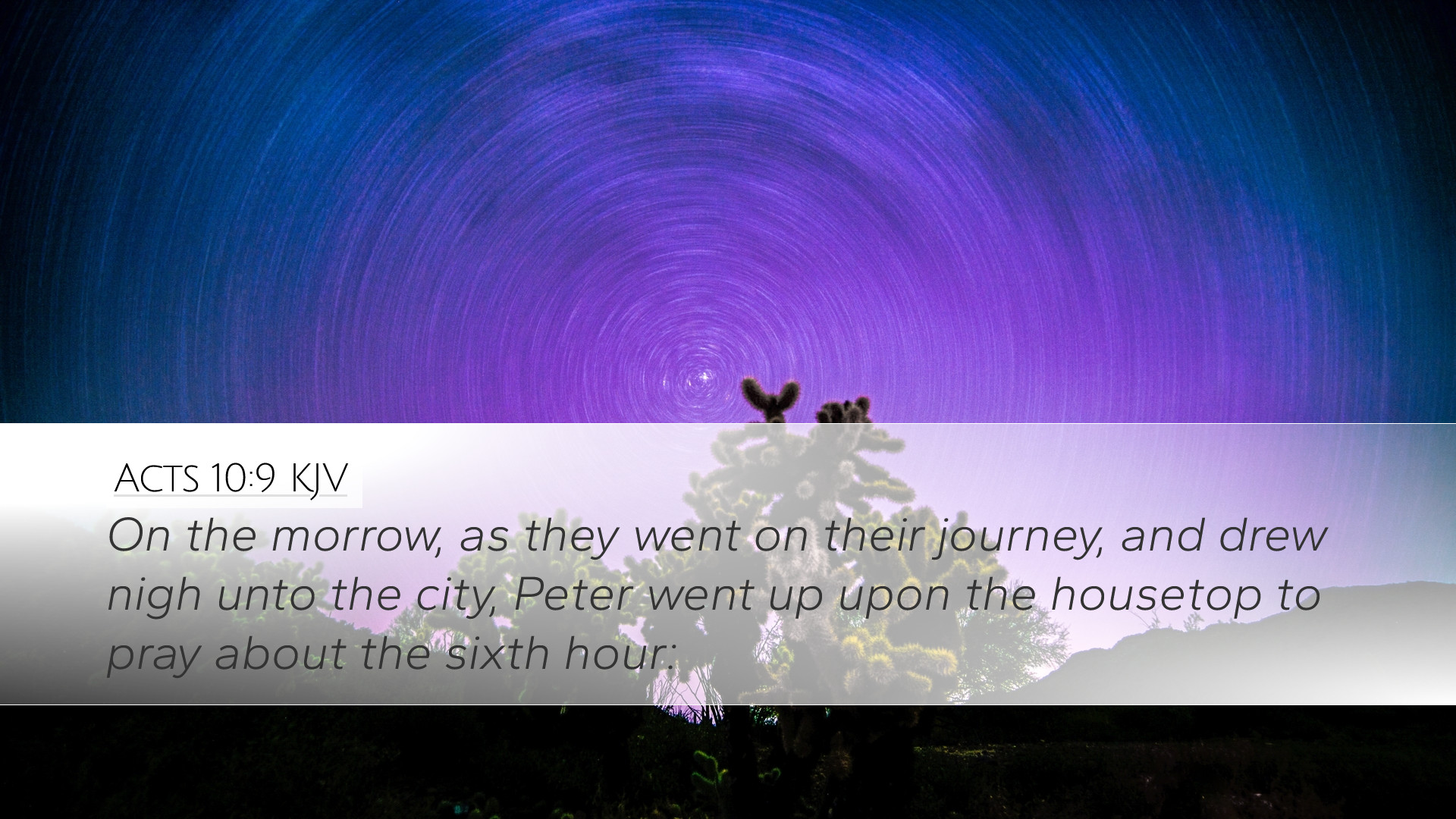Commentary on Acts 10:9
Verse Text: "On the morrow, as they went on their journey, and drew nigh unto the city, Peter went up upon the housetop to pray about the sixth hour."
Introduction
This verse marks a significant moment in the narrative of the early church, illustrating the pivotal role of prayer and divine guidance in the life of Peter and the broader mission to the Gentiles. The context here is crucial as it sets the stage for the revelation that Peter will receive concerning the inclusion of the Gentiles into the Christian fold.
Contextual Overview
As we explore this verse through the lens of several esteemed commentaries, it is essential to understand the cultural and theological implications of Peter's actions. The journey Peter is about to undertake and the prayer he engages in reflect not just personal devotion but a radical shift in the ecclesiastical paradigm of the time.
Commentary Insights
Matthew Henry’s Commentary
Matthew Henry emphasizes the importance of prayer in this passage. He notes that Peter's ascent to the rooftop to pray demonstrates the necessity of seeking divine guidance. Henry highlights that the sixth hour (noon) was a traditional time for prayer among the Jews, indicating Peter’s cultural roots and adherence to Jewish customs even as he grapples with expanding his understanding of the Gospel.
Henry further remarks that prayer is a means of aligning oneself with God's will, suggesting that Peter’s trance and subsequent vision are direct consequences of his earnest prayer life. This underscores how prayer functions not only as communication with God but also as preparation for what lies ahead in ministry.
Albert Barnes’ Notes
Albert Barnes offers a detailed examination of the phrase "went up upon the housetop to pray." He explains that rooftops in ancient Israel were often flat and used as places of reflection and prayer. This practical observation helps modern readers grasp the setting in which this significant spiritual experience unfolds.
Barnes comments on the mention of the "sixth hour," relating it to Jewish practices of prayer and sacrifice. He also points out that this timing is important, symbolically correlating with the sacrifices offered in the temple, thus connecting Peter’s personal spirituality with the communal worship of the time.
Additionally, Barnes notes that Peter’s willingness to engage in prayer just before receiving a vision signifies his readiness to approach God with an open heart, exemplifying a vital characteristic for all believers—being receptive to divine instruction.
Adam Clarke’s Commentary
Adam Clarke provides a broader theological perspective on this passage. He emphasizes the transformative nature of both Peter’s prayer and the ensuing vision as essential to the Gospel’s outreach beyond Israel. Clarke draws attention to the significance of Peter’s role as a bridge between Jewish and Gentile believers.
Clarke also highlights the spontaneous nature of divine revelations during times of prayer. He discusses how the act of prayer invites God’s presence, which often leads to crucial new understandings and directives. He posits that the vision Peter experiences is not merely a personal blessing but a foundational moment for the expansion of the church.
Theological Reflections
This verse serves as a reminder of the profound impact that prayer can have in the life of a believer. It illustrates the preparatory work of the Holy Spirit in leading Peter to a new understanding of God’s inclusivity.
Each commentary underscores the importance of maintaining a posture of prayerful readiness in the life of a believer, particularly in times of transition and revelation. For pastors and theologians, this emphasizes the necessity of prayer as a ongoing practice in the church today, advocating for divine wisdom in decision-making processes and mission strategies.
Application for Today’s Church
The themes present in Acts 10:9 remain pertinent. As contemporary believers navigate an increasingly diverse world, the command to seek God through prayer remains vital in understanding how to engage with those different from ourselves. This passage prompts reflection on how churches might be called to broaden their engagement with diverse communities.
Moreover, the divine timing highlighted in this verse suggests that believers must be attentive and responsive to God’s leading, especially in moments of prayer. Each of us is invited into a deeper relationship with God, continually prompting us to reevaluate our understanding of ministry and inclusion within the body of Christ.
Conclusion
Acts 10:9 stands as a rich narrative that transcends its historical context, speaking profoundly into the lives of believers today. Through the insights of Matthew Henry, Albert Barnes, and Adam Clarke, we derive a multi-faceted understanding of the significance of prayer and the heart of God in the mission of the church.
As we reflect on Peter’s journey through prayer and revelation, may we, too, be inspired to approach God with humility and openness, eagerly anticipating the ways He will lead us to fulfill His mission in our diverse and complex world.


